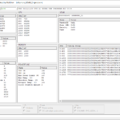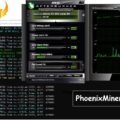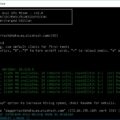

OverdriveNTool is used to overclock GPUs with AMD OverdriveN API support (290, 290x, 380, 380x, 390, 390x, Fury, Fury X, Nano, 4xx, 5xx, Vega 56, Vega 64) and API Overdrive8 GPU (in currently Radeon VII). This program replaced WattTool, which does not work with driver version 17.7.2.
Requirements:
- System: Windows 7 and newer builds.
- GPU: AMD 290, 290x, 380, 380x, 390, 390x, Fury, Fury X, Nano, 4xx, 5xx series, Vega 56, Vega 64, Radeon VII.
- Driver: 17.7.2 and newer.
FAQ:
- Error bypass in drivers 17.7.2, when the driver sometimes uses default voltages instead of user settings. Use a reset and reapply profile.
- It is possible to disable / enable each state of P. To do this, click on the shortcut P0, P1 .., etc. If the state P is disabled, it will not be used by the GPU.
- I2C currently supports: IR3567B (RX470, RX480, some RX5xx), up9505 (MSI RX5xx)
- If you prefer not to touch the fan settings. You can disable the Fan section for each GPU. To do this, press Ctrl + double-click somewhere in the fan window. It is saved in accordance with gpu_id, so the graphical interface or command line will not affect the fan settings for such a GPU.
- To open the settings or SoftPowerPlayTable editor, left-click on the program icon in the upper left corner or right-click on the title.
- To change the “friendly name”, first enable it in the settings. Then right-click the GPU list to open the menu.
How to overclock AMD GPU in OverdriveNTool
Using the OverdriveNTool utility is simple and accessible to any user. To use it, you can use any folder on the computer’s media, preferably created only for this program.
https://forums.guru3d.com/threads/overdriventool-tool-for-amd-gpus.416116/
In the program folder, the OverdriveNTool.exe utility will be located, as well as two files for managing it:
- The file to start the program in automatic mode (in this case, overdrive_BAT.bat).
- The profile file in which overclocking settings will be recorded, downvoltage, fan speeds and temperature conditions for video cards (OverdriveNTool.ini file that is automatically created when saving any profile).
Example folder contents for working with OverdriveNTool:

Using OverdriveNTool is to:
- Running the executable file OverdriveNTool;
- Studying the factory settings of AMD video cards in OverdriveNTool;
- Entering the necessary acceleration values and recording them in the OverdriveNTool.ini profile file;
- Configure the file to automatically apply the necessary parameters and include it in autorun.
When you start OverdriveNTool and click on the drop-down menu, you can see all the video accelerators installed in the system, including those that are not supported by the utility:

When you select an unsupported GPU, the program displays a warning (in this case for the AMD Radeon R9 280 video card):

To work with such GPUs, you need to use MSI Afterburner or specialized BIOS firmware for video cards.
Studying the factory settings of AMD video cards flashed in BIOS
Studying the factory settings of video cards in OverdriveNTool must be done after pressing the Reset button.
Selection of voltage values on the core of AMD video cards
AMD GPU core downvoltage values need to be selected based on from the preset table in the left column of the OverdriveNTool window:

The principle of selecting acceleration and downvolting is simple: you need to take voltage from the lower stage, and the frequency from the upper one minus one.
For example, in this case, we can hope for stable operation of the video card at a frequency of 1144 MHz with a core voltage of 912 mV.
In real life, the video card can work with two voltages. steps below, but stability in each case is necessary test separately.
The desired values are hammered into the program window and saved by pressing Save button. For the first time, the program itself will offer to create a new profile, and subsequently for each video card or new profile (for different mining algorithms overclocking may vary) you need yourself press the New button:

The profile also sets the desired fan speed (it’s best to set it at 50-60% of the maximum), the target temperature, maximum temperature and energy limit:
In the middle part of the OverdriveNTool program window, the frequency and voltage of the video memory are set.
After saving the profile, a file will be automatically created OverdriveNTool.ini with saved acceleration values and others GPU settings.
Sample text in OverdriveNTool.ini file for RX580 4GB video card, tuned for mining at a core frequency of 1110 MHz at a voltage of 840 mV, memory frequency 1950 MHz with a voltage of 860 mV:
[Profile_2]Name=0GPU_P0=300;750GPU_P1=466;818;0GPU_P2=751;824;0GPU_P3=1019;830;0GPU_P4=1074;840;0GPU_P5=1090;840;0GPU_P6=1110;840;0GPU_P7=1160;840Mem_P0=300;750Mem_P1=1000;800Mem_P2=1950;860Fan_Min=1500Fan_Max=2280Fan_Target=75Fan_Acoustic=1411Power_Temp=85Power_Target=0
Screenshot of part of OverdriveNTool.ini file for RX580 4GB video card

You can view saved profiles directly in the OverdriveNTool.ini program by expanding the Profiles list:

Edit profile settings conveniently by opening the OverdriveNTool.ini file in any text editor.
To load and verify the health of the desired profile, select it and click the Load button:

How to achieve automatic loading of the desired overclocking profile for a video card?
To automatically download the desired overclocking profile of the video card, create a batch file (batch file) with the following text (in this case, to use profiles 0,1,2,4,5 for video cards with the same numbers):
@echo Overdrive downvolt setting up
@echo off
timeout 20
OverdriveNTool.exe -p0″0″ -p1″1″ -p2″2″ -p4″4″ -p5″5″Screenshot of the batch file to run OverdriveNTool on five GPUs (0,1,2,4,5):

To restore the video cards after failures in old versions of the program, you had to add the -r command to the BAT file to reset the GPU settings to the default values: OverdriveNTool.exe -r0 -r1
Where the number indicates the number of the video card with respect to which the reset is performed.
Starting with version 0.2.7, a reset is done automatically before setting the desired values.
The batch file for automatic launch in old versions of the utility looks like this:
@echo Overdrive downvolt setting up
@echo off
timeout 10
OverdriveNTool.exe -r0 -r1 -r2 -r3 -r4 -r5
timeout 10
OverdriveNTool.exe -p0″0″ -p1″1″ -p2″2″ -p4″4″ -p5″5″The timeout value is selected individually depending on the system loading speed.
For HDD, it can be 30-50 seconds, for SSD – 5-20 seconds. At too little timeout time settings batch file may not apply, so you should not try to save a couple of seconds of work in optimal mode and completely lose the correct GPU settings.
How to add OverdriveNTool to autorun?
To start OverdriveNTool automatically, create a shortcut batch file with the profiles used at startup and place it in folder “C: Users 1 AppData Roaming Microsoft Windows Start Menu Programs Startup “, where 1 is the name of the user on behalf of which computer is loading.
Screenshot of the Windows startup folder with three programs added to startup:

List of OverdriveNTool Commands
In OverdriveNTool, you can use the following commands:
- -p [gpu_id] “name” – the values corresponding to the profile “name” are applied to the video card id = [gpu_id];
- -c [gpu_id] “Name” – the same, but a message appears with information about the success of the form:

- -r [gpu_id] – reset (reset) to the factory values for the video card with the corresponding number, starting from zero.
- cp [gpu_id] “Name” – the values for the GPU id = [gpu_id] are compared with the “Name” profile and, in case of discrepancy, the necessary settings are applied;
- cm [gpu_id] “Name” – the same, but still a message is displayed with information about finding a discrepancy;
- -consoleonly – shows all program messages recorded in the batch file after this command only in the console (instead of the graphical interface);
- -showgui – similarly, but shows all program messages in the graphical interface;
[gpu_id] – video card number, starting from zero;
«Name» – profile name.
When using more than 10 video cards you need to use numbering of profiles [gpu_id] with two digits, for example: 00.01,02,03,04,05,06,07,08,09,10,11,12.
In this case, -p04 ″ Name ”(for the fourth video card) is written in the batch file.
Using OverdriveNTool without a profile file
Using OverdriveNTool without a profile file, simply specifying in the batch file all the necessary acceleration parameters. This is done according to this syntax:
This is done according to this syntax:
-ac[gpu_id] GPU_P[num]=[value];[value][;0] Mem_P[num]=[value];[value][;0] Fan_Min=[value] Fan_Max=[value] Fan_Target=[value] Fan_Acoustic=[value] Power_Temp=[value] Power_Target=[value]
-ac in this case corresponds to the -p command and applies all the values specified below without using profiles in the ini file.
If you do not specify value values, then they are ignored.
In this case, write the desired number of the Pstate value, [num], when this the first [value] indicate the frequency of the core, and the second – the voltage in millivolts.
[; 0] means that this Pstate is turned off.
If you register * as the frequency / voltage of the memory or video core, the program will ignore this parameter. For example:
For example:
-ac0 GPU_P7 = *; 800 Mem_P3 = 1000; * (for a zero video card, applyGPU_P7 value with voltage = 800mV and memory frequency P3 equal to 1000MHZ)
When using the format *; *; 0, the corresponding Pstate value is simply turned off. For example: -ac0 GPU_P4 = *; *; 0 turns off the Pstate number of P4 without changing its values.
If you like to read such articles and want to support the author, then you can subscribe to our telegram channel and recommend us to your friends, this will help a lot to support our project! Telegram:
Be the first to know all the news, read more about cryptocurrencies and mining at CRYPTO-MINING.BLOG.
Recommended Related Articles:
What awaits Bitcoin after the 2024 halving?
The popular crypto analyst shared his vision of the development of the situation in the Bitcoin market ahead of the expected halving in April 2024. According to his analysis, the movement of the first cryptocurrency after the reduction of miners’ remuneration traditionally falls into four characteristic phases. In his opinion, if we focus on updated…
How to create, use Kaspa Wallet
Kaspa wallet is known for its user-friendliness, reliability, and high-level security features. The wallet has been built on the Bitcore platform with many lines of security such as 2-factor authentication, multi-sig support, and hardware wallet support to support digital assets stored in it. The wallet is also applauded for its smooth user interface, which makes…
BTCTools v1.3.1: Download, ip-scanner, overclocking for Windows
BTC Tools is a tool to scan, configure, reboot and update most Antminer, WhatsMiner, Innosilicon or Avalon ASICs. The utility includes ip address scanner, monitoring, batch management of overclocking of miners. … Continue ReadingBTCTools v1.3.1: Download, ip-scanner, overclocking for Windows














Essay Wilbert
Great work ,, really we were looking for a tool like this since wattool has stopped developing his tool ,
so i have an important note !!!
GPU is NOT listed the same arrangement of MSI afterburner or new claymore version
some for example I tested your tool in 2 rigs
1st rig was like this
calymore OverdriveNTool
0 1
1 0
2 3
3 2
4 5
5 4
2nd rig was like this
calymore OverdriveNTool
0 5
1 0
2 1
3 2
4 3
5 4
As you see from the previous list there is no constant rule of listing GPUs
Please fix it to be the same looks like clyamore listing
Thanks for advance